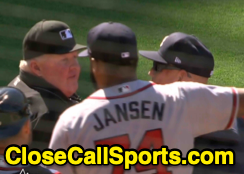MLB's pace of play rules generated a disagreement in San Diego as HP Umpire Bill Miller denied Atlanta Braves relief pitcher Kenley Jansen's attempt to throw extra warmup pitches after the mid-inning timing clock expired ahead of the bottom of the 9th inning at Petco Park.
Play: At the conclusion of the top of the 9th inning, with Atlanta leading San Diego 5-2, Braves manager Brian Snitker substituted pitcher Jansen into the game to close, and Jansen began his journey to the pitcher's mound from Atlanta's bullpen beyond the center field wall. Jansen eventually arrived at the mound and began throwing warmup pitches, completing two or three tosses before HP Umpire Miller called for the final warmup pitch and, after it had been thrown, motioned for due-up batter Manny Machado to approach home plate.
Call to Deny: Despite Jansen's attempt to continue warming up, Miller disallowed future practice pitches, generating an argument from Jansen and visit from Snitker.
The Rule: Major League Baseball's pace of play initiatives regarding between-inning and pitching change timing were instituted in 2015, with timing clocks installed in all stadiums throughout the league: the introductory time limits for between-inning and pitching change breaks were 2 minutes and 5 seconds for local broadcasts (2:25 for nationally televised games) beginning in 2016, eventually lowering both times to two-minutes, flat, in 2019.
According to
this rule, pitchers can throw as many or as few pitches as they like in their allotted time, but shall not be entitled to additional pitches if time expires, even if they only threw one or two warmups prior to that expiration of time (e.g., no guarantee or minimum of warmup throws). The timing protocol is as follows:
> At 25 seconds remaining on the clock, the umpire shall signal for the final warmup pitch.
> By 20 seconds, the pitcher shall throw the final warmup toss.
> At 20 seconds, the public address announcer shall announce the lead-off batter.
> At 5 seconds, the pitcher shall begin a windup to the batter, who must be in the box and alert.
Sidebar: San Diego's broadcast referred to an entitlement of eight warmup pitches. Note that this is the old, pre-2016 inning break/pitching change rule. The new rule is fully time clock-based.
Procedure: The between-inning timer starts when the final out is recorded or finalized by Replay Review (whichever is later), or, if there is an extended inning break (e.g., Stand Up to Cancer, playing of
God Bless America, etc.), the timer begins at the conclusion of the special event.
The pitching change clock begins when the relief pitcher crosses the warning track en route to the mound, or, in the case of on-field bullpens, crosses the foul line.
What Happened: As evidenced by Padres public address announcer Alex Miniak's "now batting Manny Machado" announcement, Jansen threw his final warmup pitch with 20- or fewer seconds remaining on the timing clock. Thus, by convention, HP Umpire Miller was obliged to prevent Jansen from throwing additional warmup pitches because his time to do so had expired, pursuant to MLB's pace of play initiatives that have become a point of emphasis under Commissioner Rob Manfred.
Video as follows:



























